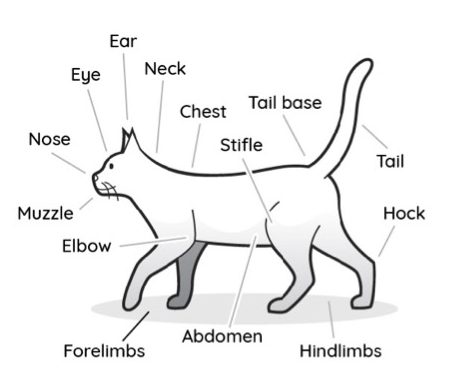Anatomy & Physiology Considerations: Student Summary
|
|
|
- Stop = forehead
- Scruff = back of neck
- Withers = space between shoulder blades
- Hock = ankle
- Stifle = knee
- Pastern = assist the paws to “shock absorb” the impact of running and jumping
- Carpals = wrist
- Muzzle = facial area

- Using dye in treats and medications (e.g. red for beef flavorings) may be illogical based on the limited color spectrum that canines observe.
- The length of a canine’s skull can impact drug selection.
- The carnivorous diet of canines affects the metabolism of medications, particularly considering the acidic environment of their gastrointestinal tract.
- Gastrointestinal tract length can vary greatly even between breeds (e.g. Chihuahuas versus Great Danes)
Vital Signs
Vital signs vary by species. It is important to recognize what is considered “normal” in our canine patients so we can appropriately monitor for drug efficacy and also for adverse effects.

Dolichocephalic vs. Brachycephalic

Pharmacokinetics

ABCB1 Gene Mutation
- P-glycoprotein (P-gp) exists in all mammalian species
- P-gp exports substances outside the cell membrane of tissues such as the brain, liver, intestine, etc. to be eliminated from the body
- P-gp is encoded by the ABCB1 gene in canines
- ABCB1 mutation results in deficient P-gp function
- Heterozygous (wild/mutant) results in decreased function
- Homozygous (mutant/mutant) results in complete loss of function

- Most herding breeds are at greater risk of ABCB1 defect, but non-herding breeds can have it as well.
- “White feet, don’t treat” is an expression often used in veterinary medicine to refer to these herding breeds that need special pharmacogenomic considerations.
- Sometimes referred to as “MDR1” mutation.
Which medications are affected by ABCB1?

Drug Elimination
Toxicity
- Alcohol (found in prescription and OTC products)
- CNS toxicity
- Estrogens (also be cautious of topical products the caregiver may be using)
- Myelosuppression
- Methylxanthines (found in coffee and chocolate)
- CNS toxicity
- NSAIDs (ibuprofen, naproxen, aspirin)
- GI and renal toxicity
- Sulfonamides
- Avoid Bactrim (“TMS”) if possible
- Make sure patient is kept well hydrated
- Keratoconjunctivitis sicca (KCS) risk
- Doberman Pinschers are very sensitive to sulfa drugs
- Xylitol (commonly found in some foods and candies, natural peanut butter, gabapentin formulations)
- Hypoglycemia
- xylitol stimulates profound release of insulin; can lead to coma and death
- Hepatic dysfunction
- Hypoglycemia

- Pinna = hairless, inner portion of ear
- Hock = ankle
- Muzzle = facial area
- Stifle = knee
- Horizontal orientation
- Cannot rely on gravitational pull to move solid dosage forms through esophagus
- Lack collarbone
- Enables twisting and turning more easily, making restraint for drug administration difficult
- Large subcutaneous (SQ) space near scruff of neck
- can accommodate large fluid volumes, enabling the administration of many drugs and fluids to this area

- The feline’s pupil shape is an adaptation that enhances their ability to see a night. In bright light, their vertical slit pupils can change the surface area of their pupil by a factor > 100.
- Humans lack a tapetum lucidum, a reflective layer of tissue that reflects light back through the retina. This is another adaptation that enhances night vision.
- Vomeronasal organ found between the hard palate of the mouth and the septum of the nose. Allows the cat to “analyze” scents, which can complicate the administration of some medications and flavorings.
- Keen ability to associate and remember smells with experiences may complicate medication administration.
- Clients and handlers may find it beneficial to create a positive association to the sound of opening medication containers.
- Cats depend on the nutrients found only in animal flesh for their survival, making them relatively uninterested in flavors associated with carbohydrates.
- Meat-based or organ flavors will be preferred by feline patients over sweet or aromatic options.
Vital Signs
Vital signs vary by species. It is important to recognize what is considered “normal” in our feline patients so we can appropriately monitor for drug efficacy and also for adverse effects.

Pharmacokinetics


Toxicity
Mechanism of Acetaminophen Toxicity

Lack of NAT2 and glutathione causes p-aminophenol being irreversible and excess lingering NAPQI → p-aminophenol & NAPQI react and cause methemoglobinemia
Other Toxicities of Note
- Azathioprine
- Myelosuppression
- Azo dyes (common in OTC urinary analgesic products)
- Methemoglobinemia
- Benzoic acids (caution with medications like metronidazole benzoate)
- Methemoglobinemia
- Enrofloxacin
- Irreversible blindness (deficiency of ABCG2 transporter)
- Permethrin (do not use canine formulations on felines)
- CNS toxicity

